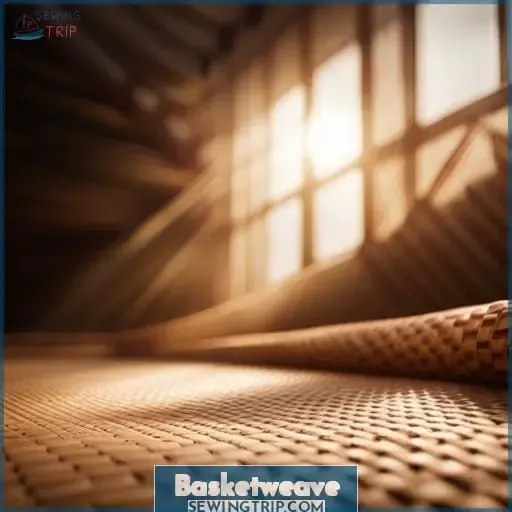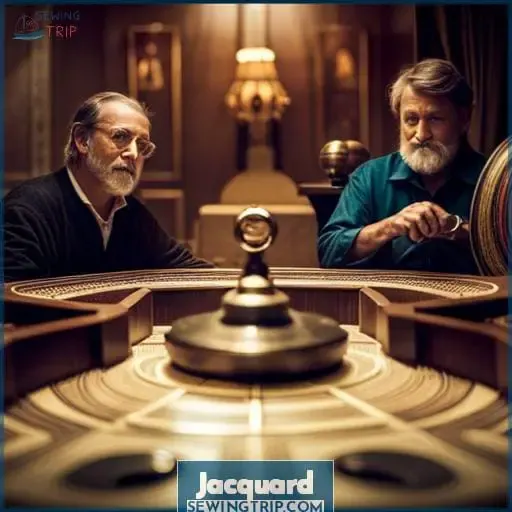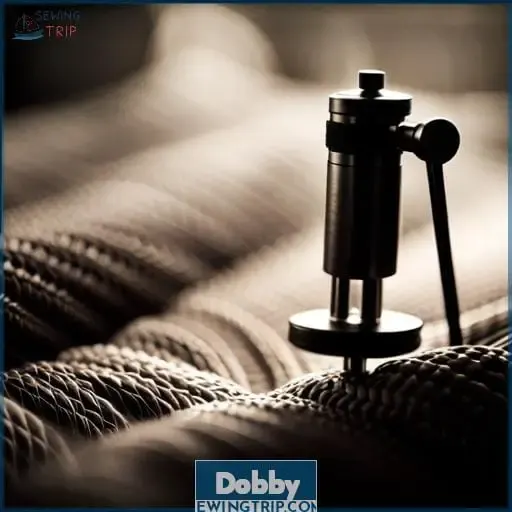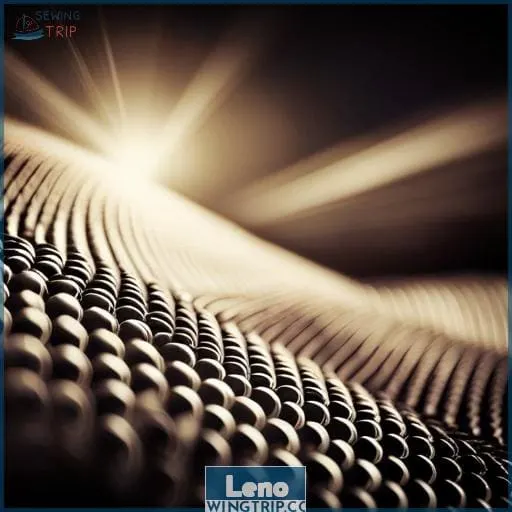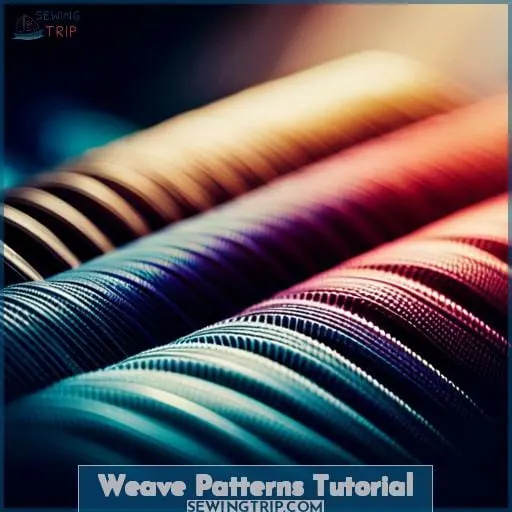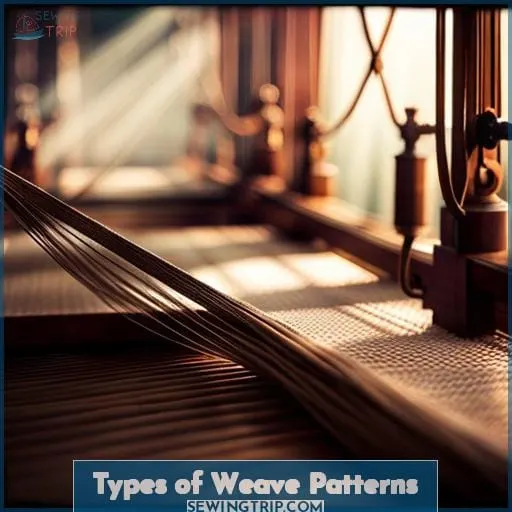This site is supported by our readers. We may earn a commission, at no cost to you, if you purchase through links.
 Embark on a journey through the intricate world of fabric creation as weave patterns unfold their fascinating tales.
Embark on a journey through the intricate world of fabric creation as weave patterns unfold their fascinating tales.
From the resilient structure of Basketweave to the artistry of Jacquard, and the distinct features of Dobby and Leno, this exploration unveils the secrets woven into each fabric.
Whether you’re a textile enthusiast or weaving novice, this guide delves into the nuances of these patterns, offering insights that empower your pursuit of Liberation, Mastery, and Innovation in the realm of textiles.
Table Of Contents
Key Takeaways
- Basketweave and dobby are versatile weaves with distinct checkerboard appearances and varied uses in fabrics and construction.
- Jacquard weaving techniques create intricate designs through punched cards and are popular in clothing and home decor.
- Weave patterns like leno and basketweave emphasize strength and texture, making them suitable for durable fabrics.
- Weaving techniques have evolved over time, influenced by cultural styles and advancements in technology, and can be manipulated to create new textures and properties.
Basketweave
As a textile specialist, navigating the intricate landscape of weave patterns is essential, and among them, the Basketweave stands out with its distinctive characteristics. Comprising a variation of the plain weave, Basketweave intricately intertwines two or more warp and weft threads, resulting in a textured fabric reminiscent of a checkerboard.
Known for its heightened strength, pliability, and a visually emphasized checkerboard appearance, Basketweave finds applications where both texture and durability are paramount.
In this exploration, we’ll unravel the characteristics and applications of Basketweave, offering insights and styling tips for those keen on understanding and utilizing this unique weaving technique.
Characteristics and Applications
If you’re delving into the realm of weave patterns, the basketweave stands out with its distinctive characteristics and versatile applications.
- Checkerboard appearance: Emphasizes texture and strength.
- Stability and density: Offers flat, durable fabric.
- Varied uses: Ideal for applications demanding texture, like construction and textured fabrics.
Styling Tips for Basketweave Fabrics
Basketweave fabrics offer versatile styling opportunities, allowing you to effortlessly incorporate textured elegance into your outfits.
Color Combinations
Layering Techniques
Accessorizing Styles
Seasonal Pairings
Textural Contrast
Jacquard
Jacquard weaving, a pinnacle in textile design, integrates complex patterns through specialized looms.
These intricate looms, employing punched cards to direct individual yarns, enable a myriad of possibilities in fabric creation.
Widely embraced in both apparel and interior decor, Jacquard techniques craft elaborate motifs with remarkable precision and finesse.
Complex Patterns and Jacquard Looms
Continuing the exploration of weave patterns, Jacquard looms epitomize creative innovation.
With Jacquard’s artistry, intricate and diverse patterns grace fabrics, revolutionizing fashion.
Its tapestries reflect mastery in complex patterns, intertwining fabric weaving and dobby weaves.
From historic looms to modern intricacies, Jacquard remains the beacon of textile liberation and artistic innovation, shaping the very essence of fabric design and weave patterns.
Versatile Uses in Clothing and Home Decor
With Jacquard’s versatility extending across clothing and home decor, you’ll find its intricate patterns adorning various fabrics and furnishings.
Textile innovations have allowed for modern applications of Jacquard weave in both fashion and interior design. The artistic interpretation of these complex patterns provides endless possibilities for design inspiration.
From luxurious upholstery to elegant drapery, Jacquard fabrics bring a touch of sophistication to any space. Additionally, the use of sustainable textiles in Jacquard weaving contributes to eco-friendly home decor options.
- Fabrics: Upholstery, curtains
- Clothing: Dresses, blazers
- Accessories: Tote bags
- Home Decor: Throw pillows
- Furnishings: Tablecloths
Dobby
Dobby weave, known for its versatility, employs a specialized loom attachment to create intricate patterns with precision.
Fabrics utilizing the dobby weave showcase geometric motifs and textures, such as the popular moss crepe or the classic polo shirt fabric, highlighting the technique’s adaptability across diverse textile applications.
The dobby weave’s controlled warp thread lifting allows for a tailored approach in fabric design, catering to both aesthetic and functional demands within the textile industry.
Distinguishing Features of Dobby Weave
Explore the distinguishing features of the Dobby weave, showcasing its unique textures and versatile applications in fabrics.
Dobby’s versatility lies in its structural intricacies, manipulating weave dynamics for varied textile nuances. This weave pattern finds applications in creating diverse fabric textures, offering a canvas for innovative designs across leno, basketweave, and jacquard techniques.
Popular Fabrics Utilizing Dobby Weave
Explore the versatility of Dobby weave through its presence in varied fabrics, showcasing its intricate patterns and texture in everyday wear.
From shirts to dresses, Dobby weaves have become synonymous with fabric innovations and trendy textiles.
The modern weave patterns of Dobby offer a unique combination of elegance and functionality, making it a popular choice among fashion enthusiasts.
Experience the dynamic possibilities of Dobby weave in contemporary fabric production and textile designs.
Leno
Leno weave is a unique type of weave pattern that involves twisting two warp yarns tightly around the weft yarn. This results in a more open and airy fabric, making it suitable for applications with lower aerial weights.
Leno weave is commonly used in construction applications where specific thicknesses need to be maintained, as well as for setting bond line thicknesses for tapes and adhesives.
Twisting Warp Yarns in Leno Weave
Now, explore Leno weave’s intricacies—twisting warp yarns to craft distinctive fabric textures.
Leno innovations enhance structural integrity, optimizing fabric durability.
These twisting techniques define Leno’s applications, influencing fabric properties and weaving history.
Embrace this weaving technique for its warp variation and innovative twist in yarns, marking a milestone in textile engineering.
Practical Applications of Leno Weave
Harnessing the versatility of leno weave spans practical textiles, creating structural meshes for apparel and industrial nets.
Weaving innovations in leno techniques deliver functional fabrics with enhanced durability.
From basketweave to jacquard, leno weave finds diverse practical applications in crafting specialized fabrics for various industries, showcasing its adaptability and strength in the realm of weave patterns.
Weave Patterns Tutorial
Embark on a tutorial unveiling the intricate world of weave patterns—an exploration that navigates through the historical evolution and fundamental understanding of weaving.
As a textile expert, delve into the basics and nuances, unraveling the tapestry of weave patterns from Jacquard’s intricate designs to the structural elegance of basketweave, Dobby’s controlled simplicity, the meticulous leno, and beyond.
Understanding these patterns is key to mastering the art of fabric construction, lending insights into their historical significance and practical applications within the textile industry.
Understanding the Basics of Weave Patterns
Unravel the intricacies of weave patterns, exploring their foundational structure and interlacing techniques.
Dive into the complexity of plain, satin, twill, dobby, and leno weaves, understanding their diverse applications across materials.
Witness the artisan techniques behind these patterns, marvel at structural innovations, and embrace aesthetic adaptations.
This journey through weave patterns unveils the artistry, functionality, and endless possibilities woven into fabrics.
Historical Evolution of Weaving and Patterns
Sometimes, exploring the historical evolution of weaving unveils textile craftsmanship’s rich development.
- Evolutionary Milestones:
- Ancient civilizations crafted intricate patterns, evolving from basic weaves to sophisticated designs.
- Cultural Influences:
- Geographic regions shaped unique weaving styles, reflecting local heritage and traditions.
- Technological Advancements:
- Innovation in looms and techniques revolutionized weaving, from artisanal methods to modern mechanization.
Types of Weave Patterns
As a textile specialist, understanding weave patterns is pivotal for fabric construction. Delving into types like Basketweave, Jacquard, Dobby, Leno, and more unravels a world of unique textures and fabric effects.
These variations offer distinct qualities crucial for diverse applications in textile engineering.
Exploring Basic Weave Patterns
Delving deeper into the realm of textile construction, explore fundamental weave patterns shaping fabric design and functionality. These patterns, such as basketweave, jacquard, dobby, and leno, reveal a historical evolution in textile artistry.
Each exhibits diverse material applications and cultural significance, offering artistic interpretations. Modern innovations continue to expand these basic weave patterns, catering to the subconscious desires for liberation, mastery, and innovation in fabric design.
| Basic Weave Patterns | Historical Evolution | Material Applications | Artistic Interpretation |
|---|---|---|---|
| Basketweave | Ancient origins | Various industries | Textured aesthetics |
| Jacquard | Revolutionary designs | Fashion, home decor | Intricate detailing |
| Dobby | Industrial revolution | Apparel, upholstery | Geometric patterns |
| Leno | Traditional roots | Mesh fabrics, curtains | Wispy, durable weave |
Variations for Unique Textures and Effects
Through the exploration of various weave patterns, you’ll discover a spectrum of textures and effects that elevate fabric uniqueness and character:
- Basketweave: Emphasizes checkerboard textures for distinct appeal.
- Jacquard: Unveils artistic interpretations with complex designs.
- Dobby: Showcases technical intricacies for diverse applications.
- Leno (Cross Weaving): Innovates design possibilities, offering unique textures and layering effects.
Frequently Asked Questions (FAQs)
How do advancements in technology impact the intricacy and variety of modern weave patterns beyond what’s historically known?
Advancements in technology revolutionize weave patterns, enabling intricate designs, precision control, and diverse materials.
Computerized looms, CAD software, and innovative materials foster limitless creativity, enhancing fabric quality, functionality, and aesthetics for modern applications.
Are there cultural significances or historical anecdotes associated with any specific weave patterns, influencing their popularity or usage in contemporary fashion?
Specific weave patterns, like Jacquard, boast cultural ties.
Originating in France, Jacquard’s intricate designs were revolutionary.
Herringbone, with roots in Roman architecture, signifies sophistication, influencing contemporary fashion due to historical eminence.
Can specific weave patterns be altered or combined to create entirely new textures or fabric characteristics that aren’t conventionally discussed in the context of traditional weaves?
Manipulating weave patterns innovatively can birth uncharted textures and properties.
Merging twill’s resilience with satin’s sheen yields lustrous strength.
Combining plain’s stability with leno’s delicacy crafts durable ethereal fabrics, defying convention.
What challenges or innovations have emerged in maintaining sustainability while producing complex weave patterns, especially in the context of materials and manufacturing processes?
To maintain sustainability while producing complex weave patterns, innovative approaches are needed.
- Utilizing eco-friendly materials
- Implementing efficient manufacturing processes
- Exploring alternative weaving techniques that minimize waste and energy consumption
In what ways do fashion trends or societal shifts influence the resurgence or decline of interest in certain weave patterns, considering their adaptability and appeal across different generations?
Fashion trends and societal shifts deeply influence the ebb and flow of interest in weave patterns. Adaptable weaves resonate with diverse generations, their resurgence often linked to a quest for timeless elegance or functional versatility.
Conclusion
To the untrained eye, fabrics merely drape or cover, but within their interlaced threads lie narratives of innovation and mastery.
Each weave pattern—Basketweave, Jacquard, Dobby, Leno—acts as a silent storyteller, echoing the expertise and creativity of textile artisans.
These patterns, with their diverse textures and applications, unlock a world of possibilities for designers and enthusiasts.
Embrace the Liberation, Mastery, and Innovation these weave patterns offer, and embark on a journey of endless textile exploration.

